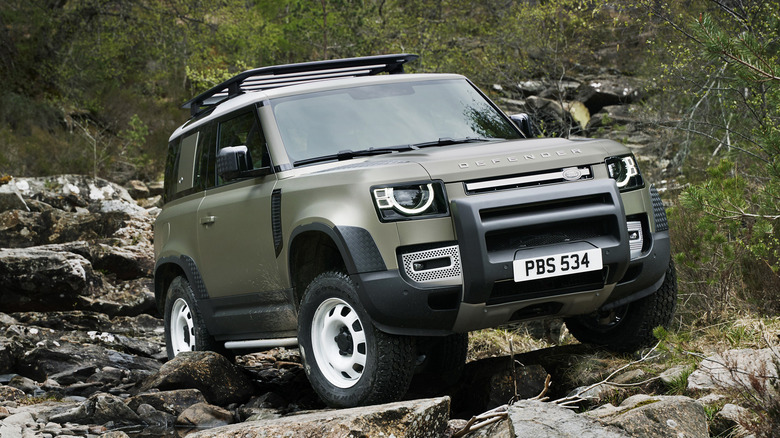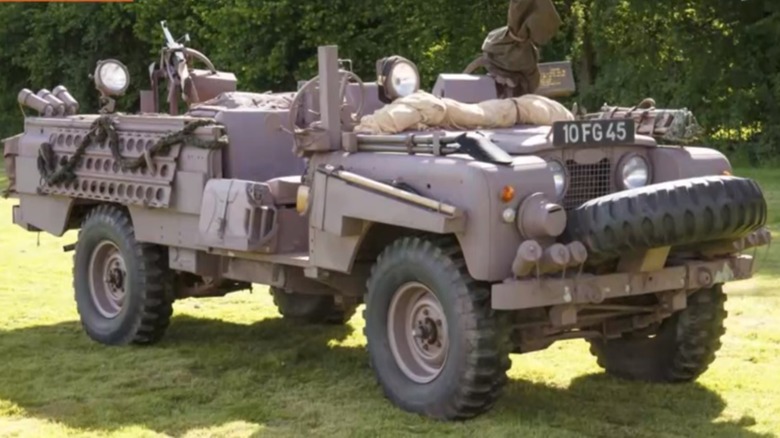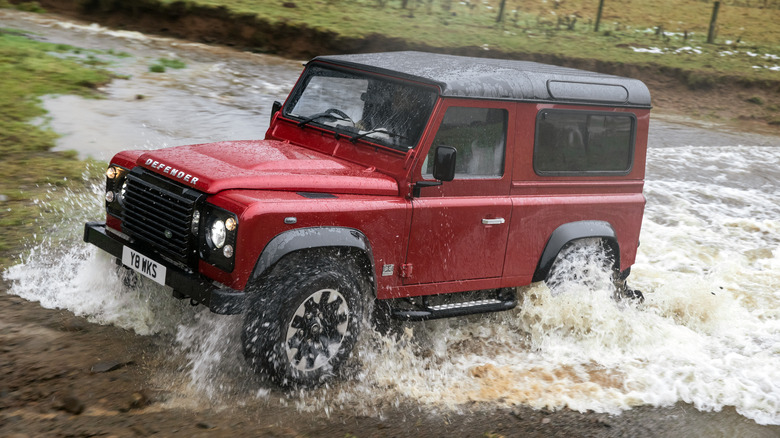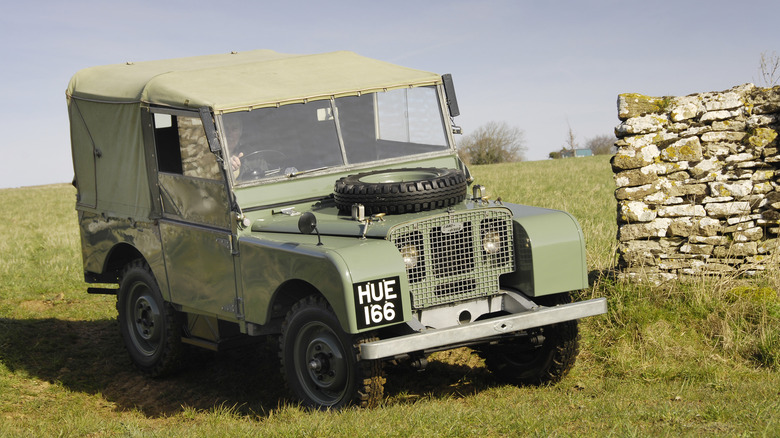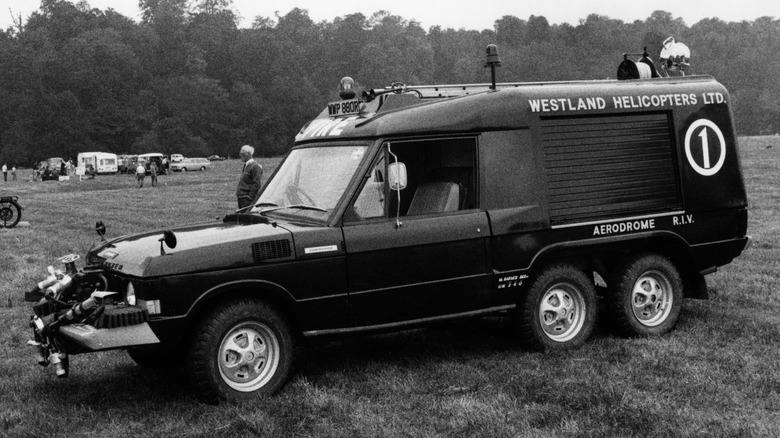The 15 Best Land Rovers Of All Time
Following the Second World War, British manufacturer Rover was looking for ways to expand its lineup into new segments. One of the most capable vehicles to emerge as a result of the war was the Willys-Overland Jeep, a favorite of both American and British soldiers. Rover decided to develop its own version of the Jeep, designed primarily for use on agricultural land. Christened the "Land Rover," the car launched in 1948 and quickly gained popularity, selling 8,000 units in its first year and attracting the attention of the British Army.
The following year, the Army commissioned Rover to build a military version of the agricultural vehicle, and shortly after that, the Royal Family requested its own custom-built "State Review" car. Since those initial successes, Britain's original SUV has been through countless evolutions, with a focus in recent years on luxury and off-road capability. Its priciest models are a world away from the brand's humble roots, but no matter what, Land Rover has always ensured that its vehicles remain some of the most capable off-roaders on the market.
Land Rover Defender Heritage Edition
When the original production run of the Defender ended in 2016, Land Rover celebrated the model's remarkable longevity by issuing a number of limited-edition specials. The Defender Heritage Edition is arguably the best of those, as it reworked the contemporary Defender to pay homage to the original Series I Land Rovers. Only 400 examples were made, each one finished in the exact same spec and in a classic shade of Grasmere Green, with steel wheels and a plaque reading "HUE 166" in honor of the first Land Rover ever made.
The Defender Heritage Edition was only available in the UK, with each listed for £27,800, roughly $38,000 today accounting for inflation. Defenders have a reputation for holding their value like almost nothing else on the UK market and considering that the Heritage Edition is the very definition of "they don't make them like they used to," resale values are likely to continue this one-way trend upwards for the foreseeable future. In 2021, a low-mileage example sold for about $59,000.
Land Rover Range Rover Classic
The original Range Rover is widely considered to be the world's first luxury SUV, and it paved the way for every other "chelsea tractor" on the market today. When it first debuted in 1970, it still had a typical Land Rover interior, which could be hosed clean after a long day's work on a farm or country estate. However, its popularity with wealthy landowners meant that it quickly became more luxurious inside, with a level of fit and finish on par with a luxury passenger car. Prince Charles, as he was then known, was very fond of the Range Rover Classic, and was often seen driving one around his Royal estates.
Plusher inside than any off-road vehicle before it, the Range Rover lost none of its all-terrain capability in its push upmarket. In 1977, a modified Range Rover won its class in the London-Sydney marathon, an 18,750-mile event that remains the longest speed-based car rally ever created. Two years later, a Range Rover won the first-ever Paris-Dakar rally, and in 1981 it took a second outright victory, (via Land Rover). Despite these successes and its popularity among Britain's wealthiest drivers, it took until 1987 for the Range Rover to be launched in North America. It was only on sale for seven years before it was replaced by the second-generation Range Rover, the P38a.
Land Rover Discovery Camel Trophy
One of the toughest and most prestigious races of its kind, the Camel Trophy was once described as the "Olympics of 4x4." Originally, the race was run using Fords, but most of them didn't survive the treacherous conditions, so the following year, Land Rover offered to make official competition vehicles for the event instead. From that point onwards, the Trophy was run solely with Land Rover vehicles, with the Discovery being one of the last custom-built Camel cars before the event was shut down.
The Discovery Camel Trophy was extensively upgraded from the stock Discovery by Land Rover's Special Installations division. Those upgrades included a heavy-duty front bumper and push bar, a winch, a snorkel, skid plates, tougher springs and shocks, and more. Power came from a 2.5L inline-4 turbo diesel engine, mated to a manual transmission (via Cars and Bids). The car's exterior was finished in Sandglow Yellow, a shade that's become intrinsically associated with the Camel Trophy over the years. There are plenty of replica Camel Trophy Land Rovers out there, but originals are rare.
Land Rover Defender (L663)
The enduring popularity of the original Defender meant that when the new generation debuted in 2020, it had some seriously big shoes to fill. However, it proved to be worth the wait, with more off-road capability than ever and a premium-yet-functional interior. It's smoother on the road than the rather agricultural original Defender, with plenty of punch available from the 3.0L inline-6. Although it's clear that Land Rover are catering more to the suburban masses than farmers with the new generation of the car, the Defender does retain the winning combination of thoughtful practicality and go-anywhere capability that made the old car such a good agricultural workhorse.
The four-door 110 is the variant that most buyers will want, but the two-door 90 variant offers the more traditional, squared-off look that differentiates it from other SUVs. The 90 is also equally good to drive, more nimble and playful than buyers might expect. There's even a Sport mode for some extra power at the lights, although buyers of the inline-6 and V8 versions shouldn't be left wanting more even in Auto mode.
Land Rover Range Rover Sport
Originally introduced in 2005, the Range Rover Sport was a jack of all trades. It featured a powerful 5.0L V8 engine, a luxurious interior, and the same off-road capability that buyers had come to expect from Land Rover. It was also smaller than a full-fat Range Rover, as it was based off the same platform as the Discovery 3, which was sold as the LR3 in North America. The Range Rover Sport combined Land Rover's signature off-road knowledge with athletic performance, making it a direct rival for the BMW X5, which had debuted a few years earlier.
It was Land Rover's first entry into the newly-emerging "performance SUV" segment, and it proved to be very successful. A second-generation of the car debuted in 2013 and demonstrated that it still retained its Land Rover DNA by becoming the first car to climb Heaven's Gate. The third-generation of the car is set to go on sale for the 2023 model year. The latest generation Range Rover Sport will also feature an electric powertrain for the first time, but there's also a twin-turbo V8 variant available for those not quite ready to give up the gasoline just yet.
Land Rover LR4
The LR4, or Discovery 4 as it was known in its home market, took many of the best elements of the brand's other vehicles and combined them into one versatile SUV. It was very much a family-oriented SUV, albeit one that could handle rough terrain a lot better than the average mall crawler. In many ways, it was more "wholly dedicated to the brand's original SUV formula" than most of Land Rover's other offerings at the time. With an old-school ladder frame construction and a 3.0L supercharged V6, the LR4 didn't feel as sedan-like to drive as its German rivals, instead feeling sturdier and smoother.
It was quite happy as a spacious commuter vehicle, shuffling the kids to school and doing the grocery run, but take it outside the comforts of asphalt roads and it came into its own. The car's Terrain Response System and optional low-range four-wheel drive ensured that the LR4 could tackle terrain much rougher than anything a BMW or Audi could handle, with ice, mud, and rocks being no trouble at all.
Land Rover Range Rover Sentinel
Land Rover's press release for the Range Rover Sentinel called it a "Fortress refined," and that seems quite a fitting description for the factory-armored SUV. Built for officials and celebrities who need more protection than a standard SUV can offer, the Sentinel can be configured to each buyer's preferences with a range of armor levels available. It's designed to look no different on the outside from a regular Range Rover, but it's kitted out with features including armored glass, roof blast protection, and an emergency escape system.
The car's interior is the same as the standard Range Rover Autobiography, as lavish as SUVs get. The latest generation of the Sentinel debuted in 2019 and comes equipped with a supercharged 5.0L V8 engine, although its heavy armor plating means that 0-60 mph still takes a rather leisurely 9.8 seconds, according to Land Rover. It also features upgrades to the chassis, suspension, and braking systems, to ensure the Sentinel is just as capable off-road as buyers have come to expect from the brand's cars.
Land Rover Pink Panther
Built for the most elite unit of the British Army, the SAS, the "Pink Panther" was given its name thanks to its unique paint scheme. It was a specially-modified Land Rover Series 2A built to survive the deserts of the Middle East, and the pink color was used because the SAS discovered it was the most effective means of camouflage in the unique environment. The story goes that this discovery was made entirely by accident, as the secretive division had originally painted an aircraft pink to make it highly visible, but crashed it in the desert, and then found it impossible to locate. The pink color was found to blend in very well with the sand, and so it was decided that the SAS' new Land Rovers should also be this color.
There was no need for the Pink Panther to feature doors, a windshield, or a roof. Instead, the car was loaded with shovels, navigation equipment, jerry cans, and of course, plenty of guns. Only 72 Pink Panthers were ever made, and only around 20 survived their military service, reports Silodrome. They were sold off to private collectors, and thanks to their rarity and unique backstory, they're among the most collectible Land Rovers on the market today.
Land Rover Range Rover State Review
The British Royal family has a long history with Land Rover, and the company has built several vehicles specifically for its use. The first "State Review" Land Rover entered service in 1953, and since then three more have been built. The most recent is the Range Rover State Review, formally unveiled by the late Queen Elizabeth II in 2015. The custom-built vehicle features a hybrid system to reduce emissions, which helped the company win the Queen's Award for Enterprise in Sustainable Development the same year.
The most unique element of the State Review car is the platform at the rear, which features an open top so that the Queen could stand and wave at her subjects while being driven through parades. The car was built especially to Her Majesty's wishes. With King Charles III on the throne, it's unclear whether he will continue using the current State Review Range Rover. As Prince, he developed a reputation for being a passionate environmentalist, and with the first EV Land Rovers on the way soon, it would seem fitting for the King to commission a new State Review car to reflect this greener technology.
Land Rover Defender Works V8
The original production run of the Defender ended in 2016, but two years later, Land Rover celebrated its 70th birthday by announcing a "new" variant of the classic model. These weren't actually new Defenders, but instead, 2015 and 2016 model year cars that had been re-acquired by Land Rover and sent back to its specialist Classic division for an upgrade. Each car was refitted with a brand new V8 engine making 400 horsepower and 380 lb-ft of torque, mated to an eight-speed automatic transmission with the "trigger" shifter taken from the Jaguar F-Type (via Auto Express).
A number of upgrades helped the Defender manage its power upgrade, including new springs, anti-roll bars, and performance brakes. The car sported new 18-inch alloys and BFGoodrich off-road tires to differentiate it from other, lesser variants. The Defender Works V8 was limited to just 150 units, and build slots sold out quickly upon launch.
Land Rover Range Rover Sport SVR
The Range Rover Sport SVR was introduced in 2015 and brought a whole new level of performance to the Land Rover range. With 542 horsepower on tap from its 5.0L V8 engine, the car could pull from 0-60 mph in just 4.7 seconds, and reached an electronically limited top speed of 162 mph, according to Parkers. Impressive for a sports car, never mind an SUV that weighs over 5,000 lbs. The SVR's exhaust note was also unlike anything Land Rover had made before, with its quad pipes generating a thunderous roar under full acceleration.
It featured a comprehensive suite of intelligent assists to complement its increased power, including a Dynamic Active Locking Rear Differential and a Corner Recognition system for the transmission (via Parkers). This allowed it to corner faster and flatter than any other Land Rover before it, making it feel genuinely sporty to drive than many other performance SUVs. The SVR had a revamp for the 2022 model year, with a range of new colors and a slight bump in power. For 2022, the car can now reach a top speed of 176 mph and achieve 0-60 mph in just 4.3 seconds.
Land Rover HUE166
The first Land Rover ever made wears the registration plate HUE166, and it's referred to as "Huey" by fans of the brand. It was sold to a local farmer, then eventually restored and brought back to factory spec by Land Rover. It might be an icon, but Huey isn't the easiest to drive, with one reviewer calling it "a culture shock" after a morning of driving a modern Range Rover. The car packs a meager 50 horsepower and gear changes require the use of a lever that juts out of the bare metal floor, while almost every mechanical element of the car makes its own crunch or whine.
It might have been rudimentary, but the original Land Rover triumphed in one key way that its inspiration, the Willys-Overland Jeep, did not: it didn't get bogged down in thick British mud. That alone was enough to make it a hit with farmers all over the country, and soon Rover's books were filling with thousands of orders both from home and abroad, according to The National. After being bought back and restored by Land Rover, Huey now sits in the company's heritage collection, and it's now on permanent display at the British Motor Museum in Warwickshire.
Land Rover Range Rover Carmichael
A 6x6 SUV is no longer the unicorn it once was, as Mercedes-AMG G63 6x6 and the Hennessey VelociRaptor both offer deep-pocketed buyers a chance to buy one straight from the factory. However, there has never been a factory 6x6 Range Rover, unless you count the Carmichael 6x6 of the '70s. Designed primarily as a vehicle for emergency services working in remote locations, only 400 coach-built Carmichaels were ever made according to Classic Driver, and far fewer survive to the present day.
Carmichael was a coachbuilder based in Worcester, England, and offered a range of 6x6 conversions for the Range Rover, the most popular conversion being a fire truck. Very few were ever converted for private use, and the few that were are highly coveted collectors' items today. According to Range Rover Classic, some were also converted as personnel carriers for rabbit and pheasant hunting. All Carmichael Range Rovers came with full Rover approval and a factory warranty, and they were designed so that all parts were available from a regular Rover stockist.
Land Rover Defender SVX Spectre
Combining two classic British icons into one, the Defender SVX Spectre was built especially for the James Bond movie of the same name. Each one was based on a 110 pickup and featured a number of modifications to tackle the tough terrain that was used for filming. To prepare the cars, Land Rover enlisted the help of racing specialist Bowler, who had been making competition-spec Land Rovers for decades. Bowler added extra body protection to guard against bumps and scrapes, and huge 37-inch Maxis Trepador tires that were bolted onto Beadlock alloy wheels.
The car's power output was boosted to 185 horsepower from 120 horsepower, and Recaro seats with four-point harnesses ensured that drivers were kept firmly in place throughout chase scenes (via Tom Hartley Jnr). Not every Spectre Defender survived filming, and some that did were never registered for the road. However, a small handful did get registered and sold off to private collectors. They rarely come up for sale, and when they do, they command prices that a top-spec Range Rover would struggle to reach. At the time of writing, one is currently for sale at a British specialist dealer for £245,000 ($271,000).
Land Rover Range Rover Supercharged LWB
For millionaires who want the highest level of luxury wrapped up in an all-terrain SUV, it doesn't get better than a Range Rover Supercharged LWB, "SUV royalty," that gives the driver a sense of superiority over everything else on the road. It's not as shiny or overbearing as many other luxury trucks, preferring to opt for discreet elegance instead.
Inside, it's an excellent blend of traditional and modern, with hand-crafted leatherwork nestled opposite sleek infotainment systems and touchscreen controls. The windows are tinted for added privacy, but there are also power blinds in the rear for total isolation from the outside world. The rear of the cabin is less tech-heavy than one might expect from such a pricey car, instead focusing on comfort and simplicity. It's perhaps the ultimate luxury Range Rover, for the lucky few fans of the brand who can afford it.




